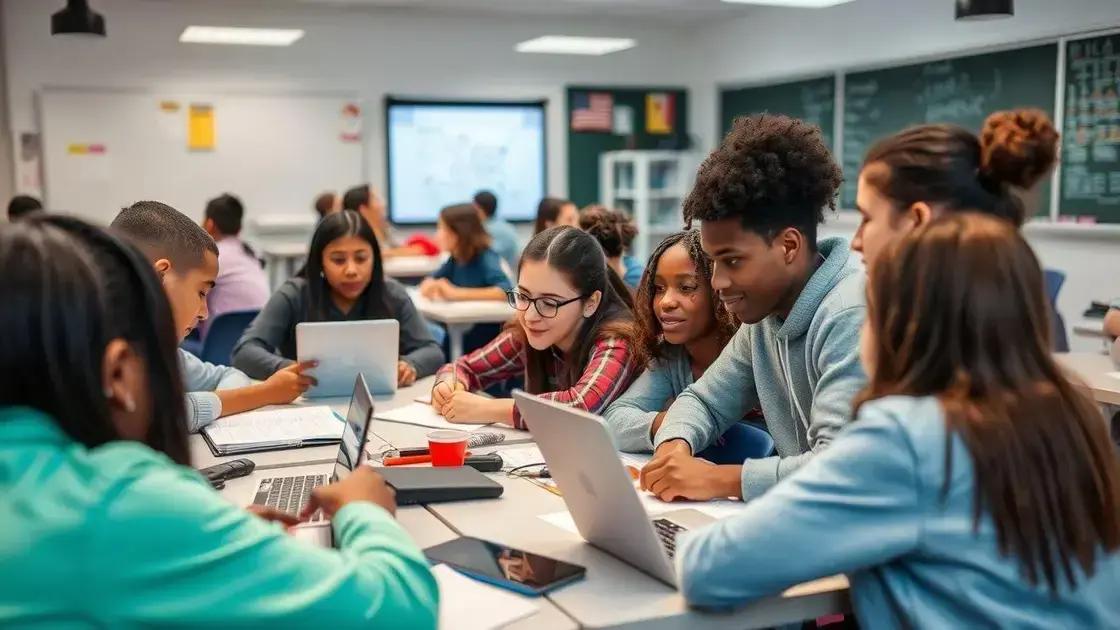Education policy shifts: adapting to modern needs

Anúncios
Future trends in education policy focus on integrating technology, ensuring equity, promoting social-emotional learning, and involving student voices to create a more effective and supportive educational environment.
Education policy shifts are reshaping how we view teaching and learning in today’s world. Have you ever wondered how these changes influence our schools and students? Let’s dive into this important topic and discover the implications.
Anúncios
Understanding education policy shifts
Understanding education policy shifts is essential in today’s rapidly evolving educational landscape. These shifts aim to meet the changing needs of students and society. They reflect ongoing debates about what education should accomplish.
Policymakers often consider various factors when implementing education policy shifts. This includes thinking about how to enhance learning environments and promote equity among students. As we explore this topic, it’s important to recognize the impact these policies have on teachers, students, and communities.
Anúncios
Key Factors Influencing Education Policy Shifts
Several key factors shape the direction of education policies:
- Technological advancements that change teaching methods
- Shifts in societal expectations regarding education outcomes
- Research-backed approaches to improving student success
- Calls for equitable education for all students
As education policy evolves, it also seeks to integrate the use of technology. Modern classrooms often employ digital tools to enhance engagement and learning. Education policy shifts encourage schools to adopt innovative practices that utilize these technologies effectively. Additionally, fostering collaboration between educators, parents, and communities helps to create a supportive learning environment.
The Role of Stakeholders
Different stakeholders play a vital role in shaping education policy shifts. This includes government officials, educators, parents, and even students themselves. Open communication among these groups is essential. Educators can provide insights into what works in the classroom, while parents can share their expectations and concerns.
When stakeholders collaborate, they can develop policies that truly reflect the needs of students and educators. This collaborative approach leads to more effective educational systems and better learning outcomes.
Ultimately, education policy shifts are about adapting to new challenges and opportunities. By understanding these changes, we can support a system that fosters lifelong learning for all.
The impact of technology on education policies
The impact of technology on education policies is profound and far-reaching. As more schools incorporate digital tools and resources, policies must adapt accordingly. Recognizing the role of technology is key to understanding how it shapes learning experiences.
Recent trends show a growing reliance on technology in classrooms. With online resources, students can access a wealth of information. This shift requires education policies to address the integration of technology effectively.
Enhancing Learning Through Technology
Technology enhances learning by:
- Providing personalized learning experiences
- Facilitating collaboration among students
- Offering access to real-time data and resources
- Supporting diverse learning styles
These advancements are not just beneficial; they are necessary for preparing students for a tech-driven future. Education policies must create frameworks that support effective technology use.
Policy Changes Driven by Technology
As technology evolves, so do education policies. Schools are now expected to adopt digital platforms and tools. This includes learning management systems and virtual classrooms. Such tools are essential for modern teaching practices.
Policies are now shifting to include training for teachers on how to use technology effectively. When teachers are equipped with the right skills, they can maximize the benefits of digital tools in their classrooms. This training is crucial for ensuring that technology enhances, rather than hinders, the educational process.
Furthermore, data privacy and security are important considerations in education policies. As technology becomes more integrated into learning environments, policies must protect students’ personal information while allowing for innovation.
Equity in education: addressing disparities
Equity in education is a vital topic that addresses disparities among students. It’s important to focus on how every student has access to quality education, regardless of their background. Equity ensures that all learners receive the resources and support they need to succeed.
Many factors contribute to educational disparities. These can include socio-economic status, geographic location, and access to technology. Understanding these issues allows policymakers to create targeted strategies that promote fairness in education.
Challenges to Educational Equity
Some common challenges include:
- Limited resources for schools in low-income areas
- Variability in teacher quality
- Access to advanced coursework and extracurricular activities
- Cultural biases in curriculum and assessment
These challenges can hinder students from reaching their full potential. Addressing these challenges is crucial to building an equitable education system.
Strategies for Promoting Equity
Adopting effective strategies can help promote equity in education. Schools can implement programs that target disadvantaged students, focusing on their specific needs. This involves providing additional support, tutoring, and mentorship.
It’s also essential to involve families and communities in the educational process. When parents and local organizations collaborate with schools, they can help bridge gaps in resources and support. This collaborative approach creates a more inclusive environment and empowers students to participate actively in their learning.
By fostering a culture of equity, schools can ensure that all students have the opportunity to succeed. This commitment to fairness not only benefits individual learners but also strengthens society as a whole.
Teacher training amid policy changes

Teacher training amid policy changes is essential for effective education. As education policies evolve, so too must the skills and knowledge of teachers. Ongoing training helps educators adapt to new methods and understand the implications of these policies.
One major focus of teacher training is technology integration. Many current policies emphasize the use of digital tools in the classroom. By providing practical training, schools can empower teachers to incorporate technology effectively into their lessons. This ensures that students benefit from modern learning environments.
Key Components of Effective Teacher Training
Effective training programs should include:
- Workshops on innovative teaching methods
- Hands-on experience with educational technology
- Collaboration with peers to share best practices
- Regular feedback and support from administration
These components help foster a culture of continuous improvement among educators. When teachers feel supported and informed, they can better meet the needs of their students.
Addressing Policy Changes
Teacher training must also address specific changes in education policy. Understanding new standards and regulations is crucial for compliance and effective teaching. Districts need to communicate changes clearly and provide training that aligns with these updates.
Additionally, teachers should be involved in discussions about policy changes. Their insights can help shape the training they receive. This collaborative approach leads to more relevant professional development opportunities that directly address classroom needs.
Ultimately, effective teacher training amid policy changes ensures that educators are prepared to provide high-quality instruction, adapting to evolving standards and supporting their students’ success.
Student voices in shaping education policy
Student voices play a critical role in shaping education policy. Engaging students in discussions promotes a sense of ownership over their education. When their opinions are valued, students become more invested in their learning.
Listening to students helps policymakers understand what works in the classroom. Their unique perspectives can highlight the challenges they face. For example, they may express concerns about course material, school resources, or teaching methods.
Benefits of Involving Students
Here are some benefits of including student voices in policy decisions:
- Empowerment: Students feel more empowered to speak up and advocate for their needs.
- Relevance: Policies become more relevant when they accurately reflect the student experience.
- Enhanced Engagement: Students are more engaged in learning when they feel their opinions are heard.
- Collaboration: It fosters a collaborative school culture built on mutual respect.
Incorporating student feedback into education policy leads to more effective and meaningful solutions. Schools can create focus groups, surveys, or forums where students can share their thoughts openly.
Examples of Student Impact
Numerous initiatives highlight the importance of student voices. Some schools have established student advisory councils that meet with school administrators regularly. These councils provide direct input on policies affecting their education. Additionally, students have successfully lobbied for changes in dress codes, bathroom accessibility, and mental health resources.
Such actions demonstrate the power of students to effect change. When they take an active role, they contribute to creating a more supportive and inclusive educational environment.
Ultimately, allowing student voices to shape education policy enriches the learning experience and creates a community that values input from everyone.
Parent and community involvement in education
Parent and community involvement in education is crucial for student success. When families and communities engage with schools, it creates a supportive learning environment. This involvement helps students feel valued and accountable for their education.
Strong partnerships between schools and families can lead to better academic performance. When parents participate in their children’s education, they inspire them to take school seriously. Parents can contribute by attending meetings, volunteering at school events, or helping with homework.
Benefits of Involvement
Involving parents and the community brings various benefits:
- Improved Student Achievement: Students tend to perform better academically when their parents are involved.
- Better Behavior: Students often have fewer discipline issues.
- Enhanced Communication: Stronger relationships between parents and teachers lead to better understanding of student needs.
- Community Support: Schools that engage with the community often receive more resources and support.
Schools can create programs that encourage parent participation. Examples include workshops on how to support learning at home and events that invite families into the classroom.
Community Partnerships
Community organizations can also play a key role in education. They provide resources and support that enhance student learning. For example, local businesses might offer internships for students, while libraries host tutoring programs.
Building these partnerships requires open communication and collaboration. Schools should actively reach out to community members and organizations. By working together, they can address challenges and create a more enriching educational experience for all.
Parent and community involvement in education not only enriches the learning experience for students but also fosters a stronger sense of community.
Evaluating the effectiveness of policy changes
Evaluating the effectiveness of policy changes is essential in the education sector. This process helps determine if new policies meet their intended goals and how they affect students, teachers, and schools.
Effective evaluation involves collecting data and gathering feedback from various stakeholders. This feedback should come from students, parents, teachers, and administrators. It provides insights into how policies are implemented in real-life scenarios and highlights any areas for improvement.
Key Methods of Evaluation
There are several ways to evaluate the impact of policy changes:
- Surveys: Conducting surveys can gather opinions on the new policies and their impacts on the educational environment.
- Academic Performance Data: Analyzing students’ academic results before and after the policy changes provides valuable insights into effectiveness.
- Focus Groups: Meeting with smaller groups of stakeholders can uncover detailed perspectives on the policy changes.
- Longitudinal Studies: Tracking students over time helps identify long-term effects of policies.
Using a combination of these methods ensures a comprehensive evaluation process. It allows schools to understand the strengths and weaknesses of new policies and make data-driven decisions for future improvements.
Adapting Based on Feedback
Evaluating policy changes is not just about measuring success; it is also about adapting based on what is learned. Schools must be flexible enough to revise policies that do not yield the desired results.
When evaluation reveals that certain policies are ineffective, it is crucial to consider alternative approaches. This can involve pilot programs, further training for teachers, or increased resources for students. Change is an ongoing process, and being open to feedback is essential for continuous improvement.
Ultimately, evaluating the effectiveness of policy changes in education leads to better outcomes for all stakeholders involved, ensuring that resources and efforts are used effectively to support student learning.
Future trends in education policy

Future trends in education policy are shaped by rapidly changing societal needs and technological advancements. Policymakers are beginning to recognize the importance of adapting education systems to prepare students for a dynamic world.
One significant trend is the increasing integration of technology into learning environments. Online learning platforms and digital tools are becoming essential components of the educational experience. This shift encourages personalized learning, allowing students to progress at their own pace.
Key Factors Influencing Future Trends
Several factors are influencing future trends in education:
- Equity and Access: Ensuring that every student has access to quality education and resources is a growing focus. Policies will likely prioritize closing the achievement gap.
- Social-Emotional Learning: Future policies may emphasize the importance of social-emotional skills alongside academic achievement, recognizing their role in student success.
- Workforce Development: Education systems are increasingly aligning with workforce needs. This means emphasizing skills that are relevant in the job market.
- Global Citizenship: Teaching students to be informed and engaged citizens in a global community is becoming a priority for many educators.
These factors will shape how schools develop curricula and assess student performance. As education policies evolve, collaboration between educators, policymakers, and the community will be vital.
The Role of Data and Research
Data and research will play a significant role in informing these future trends. Policymakers will rely on evidence-based practices to implement effective strategies. This approach ensures that education policies are effective and aligned with students’ needs.
Moreover, involving students in discussions about their education will likely become more common. Their feedback can help shape policies that truly reflect their experiences and aspirations, further promoting engagement in learning.
As we look to the future of education policy, embracing innovation and focusing on the holistic development of students will be essential for success.
FAQ – Frequently Asked Questions about Education Policy Trends
What are the key trends shaping future education policies?
Key trends include technology integration, equity in access to education, social-emotional learning, and the involvement of student voices in decision-making.
How does technology integration benefit students?
Technology integration allows for personalized learning experiences and makes educational resources more accessible to all students.
Why is student involvement important in education policy?
Involving students in education policy ensures that their needs and perspectives are heard, leading to more effective and relevant policies.
What is social-emotional learning and why does it matter?
Social-emotional learning focuses on developing students’ emotional skills, which is crucial for their overall well-being and academic success.






